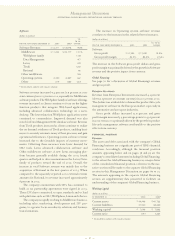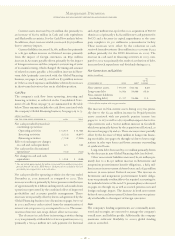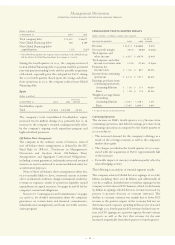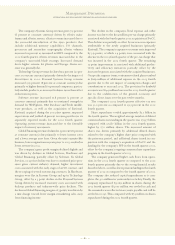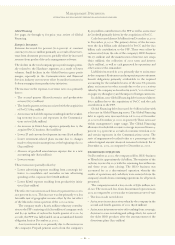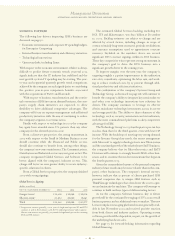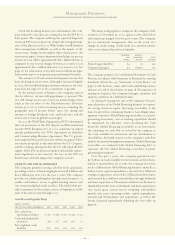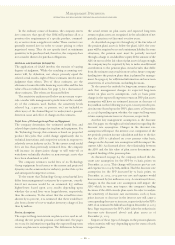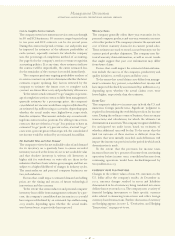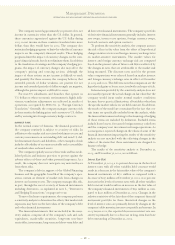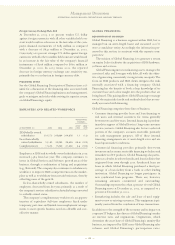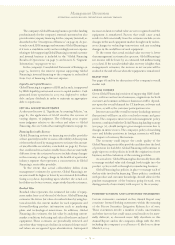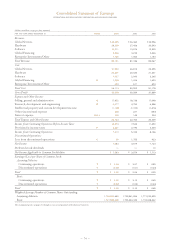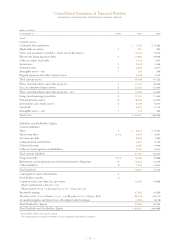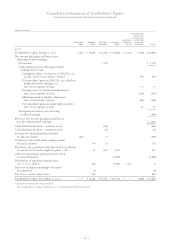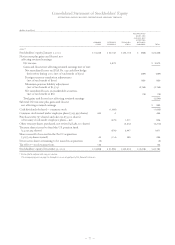IBM 2003 Annual Report Download - page 69
Download and view the complete annual report
Please find page 69 of the 2003 IBM annual report below. You can navigate through the pages in the report by either clicking on the pages listed below, or by using the keyword search tool below to find specific information within the annual report.
Costs to Complete Service Contracts
The company enters into numerous service contracts through
its SO and BCS businesses. SO contracts range for periods up
to ten years and BCS contracts can be for several years.
During the contractual period, revenue, cost and profits may
be impacted by estimates of the ultimate profitability of
each contract, especially contracts for which the company
uses the percentage-of-completion method of accounting.
See page 81 for the company’s services revenue recognition
accounting policies. If at any time, these estimates indicate
the contract will be unprofitable, the entire estimated loss
for the remainder of the contract is recorded immediately.
The company performs ongoing profitability analyses of
its services contracts in order to determine whether the latest
estimates require updating. Key factors reviewed by the
company to estimate the future costs to complete each
contract are future labor costs and productivity efficiencies.
To the extent actual estimated “to go” margins on percent-
age of completion services contracts differ from management’s
quarterly estimates by 1 percentage point, the company’s
consolidated net income would have improved/declined by
an estimated $35 million using 2003 results, depending upon
whether the actual results were higher/lower, respectively,
than the estimates. This amount excludes any accrual result-
ing from contracts in loss positions. For all long-term services
contracts that are either in a “to go” loss position or have an
estimated “to go” profit of 5 percent or less, if actual “to go”
costs were 5 percent greater than expected, the consolidated
net income would be reduced by an estimated $13 million.
Net Realizable Value and Client Demand
The company reviews the net realizable value of and demand
for its inventory on a quarterly basis to ensure recorded
inventory is stated at the lower of cost or net realizable value
and that obsolete inventory is written off. Inventory at
higher risk for writedowns or write-offs are those in the
industries that have lower relative gross margins and that are
subject to a higher likelihood of changes in industry cycles.
The semiconductor and personal computer businesses are
two such industries.
Factors that could impact estimated demand and selling
prices are the timing and success of future technological
innovations and the economy.
To the extent that semiconductor and personal computer
inventory losses differ from management estimates by 5 per-
cent, the company’s consolidated net income in 2003 would
have improved/declined by an estimated $42 million using
2003 results, depending upon whether the actual results
were better/worse, respectively, than expected.
Warranty Claims
The company generally offers three-year warranties for its
personal computer products and one-year warranties on most
of its other products. The company estimates the amount and
cost of future warranty claims for its current period sales.
These estimates are used to record accrued warranty cost for
current period product shipments. The company uses his-
torical warranty claim information, as well as recent trends
that might suggest that past cost information may differ
from future claims.
Factors that could impact the estimated claim informa-
tion include the success of the company’s productivity and
quality initiatives, as well as parts and labor costs.
To the extent that actual claims costs differ from manage-
ment’s estimates by 5 percent, consolidated net income will
have improved/declined by an estimated $30 million in 2003,
depending upon whether the actual claims costs were
lower/higher, respectively, than the estimates.
Income Taxes
The company is subject to income taxes in both the U.S. and
numerous foreign jurisdictions. Significant judgment is
required in determining the worldwide provision for income
taxes. During the ordinary course of business, there are many
transactions and calculations for which the ultimate tax
determination is uncertain. The company recognizes liabilities
for anticipated tax audit issues based on estimates of
whether additional taxes will be due. To the extent that the
final tax outcome of these matters is different from the
amounts that were initially recorded, such differences will
impact the income tax provision in the period in which such
determination is made.
To the extent that the provision for income taxes
increases/decreases by 1 percent of income from continuing
operations before income taxes, consolidated income from
continuing operations would have declined/improved by
$109 million in 2003.
CURRENCY RATE FLUCTUATIONS
Changes in the relative values of non-U.S. currencies to the
U.S. dollar affect the company’s results. At December 31,
2003, currency changes resulted in assets and liabilities
denominated in local currencies being translated into more
dollars than at year-end 2002. The company uses a variety of
financial hedging instruments to limit specific currency
risks related to financing transactions and other foreign
currency-based transactions. Further discussion of currency
and hedging appears in note L, “Derivatives and Hedging
Transactions,” on pages 96 to 99.
Management Discussion
INTERNATIONAL BUSINESS MACHINES CORPORATION AND SUBSIDIARY COMPANIES
67


